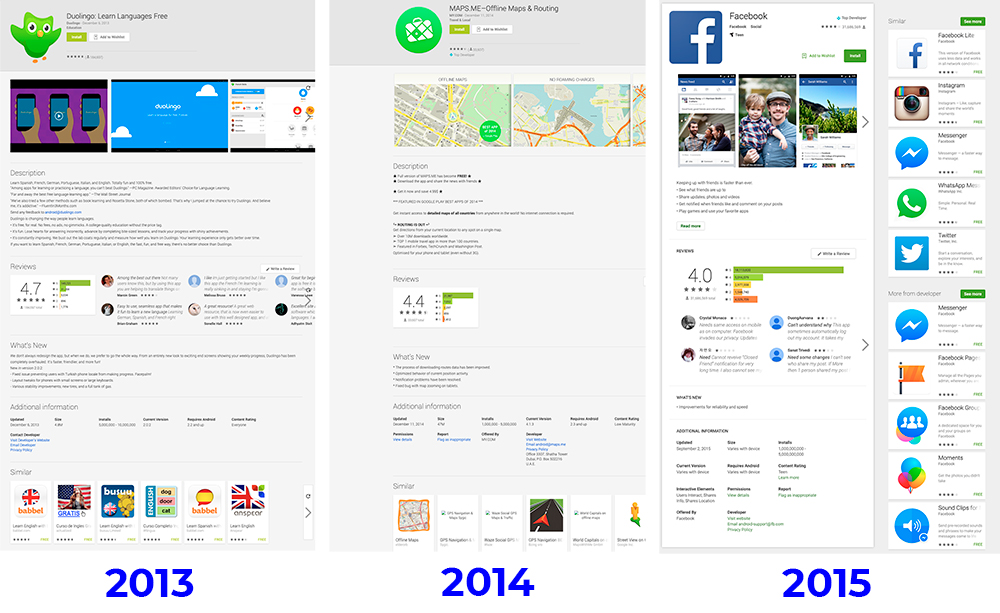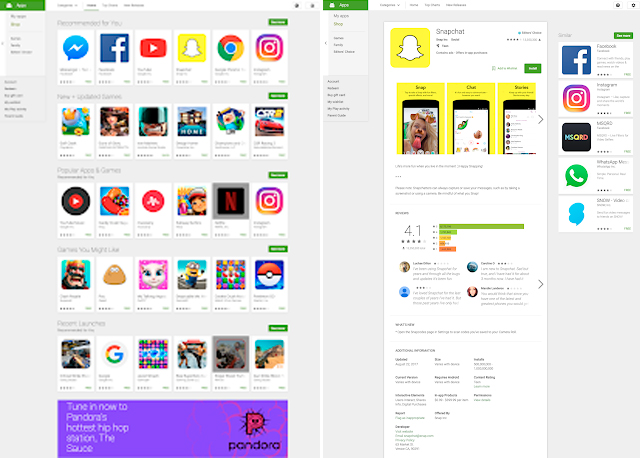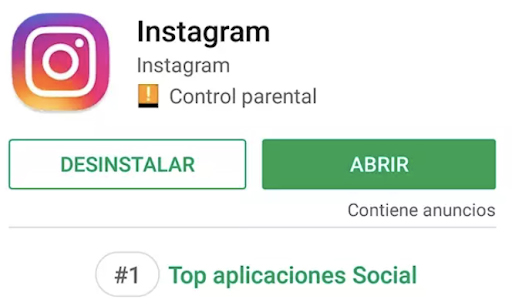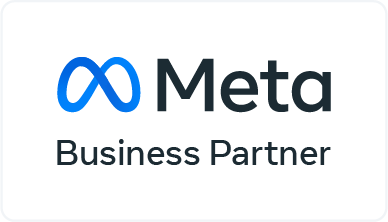This article was prepared by Borja García-Peña.
Maybe you don’t remember, but Google Play Store has not always been the biggest app store worldwide as we know it today. On October 2018, we celebrated the 10th anniversary of Android’s store that was launched in 2008 under the name of Android Market, and then renamed Google Play Store.
Tabla de contenidos
- Google Play Store: evolution of the store between 2010 and 2020
- 2010. The beginning of the war against App Store
- 2011. Small changes, but significant
- 2012. Google Play Store arrived!
- 2013-2015. New characteristics arriving to Google Play Store
- 2016. The year of apps betas changes
- 2017. Between innovation and user protection
- 2018. A glancing year on Google Play Store
- 2019. A lot of news for apps developers
- 2020. News on the store
- Evolution of Google Play Store – Conclusions
Google Play Store: evolution of the store between 2010 and 2020
Before, when you wanted to download an app or game, you had to download it from Android Market. If you wanted music, you had to download it from Google Music. To download a book, you had to do it from Google eBookstore. Grouping all the stores together in one was hard but it was one of the best decisions taken by Android, as it made it easier for users to find what they were looking for in an only app and, above all, it improved the reach of its operative system.
But Google Play Store, in spite of this big change in 2012, did not stop doing renovations and improvements of its store to offer its users and developers the best experience possible. In this post we will review all the changes of the store and the app listings in the last decade of the marvelous Android app store.
2010. The beginning of the war against App Store
As we said before, in 2010 Google Play Store was still named Android Market and its design was quite outdated compared to its competitor “App Store”.
During this year, free and paid apps were already available. This version of the Android Market only made it possible to look for apps through category filters. On the other hand, at the end of July the store reached 100k apps available.
Also, the description and the screenshots of the app could be viewed without leaving the general page of the apps (as you can see in the image right below).
*Data: Since version 1.0 of Android Market, apps could be downloaded but developers could not add paid apps until the next version.
2011. Small changes, but significant
Going from 2010 to 2011 was a tremendous change for the store. A prelude of what was going to happen the next year with the name and design change of the Google Play Store.
In 2011, the store was almost totally reformed, showing Top free apps and Top paid apps in a much more visual way, as well as featured apps or trending apps. Also, unlike during previous years, it was already possible to do a concrete search from the store’s own search bar.
On the other hand, in the apps listing, the apps developed by the same developer were added, as well as the option to add a video. Also, it was possible to navigate in the listing in the “General”, “Users comments”, “What’s New” and “Permissions” sections.
In February 2011, Android Market Webstore was launched to the market, which allowed the brand to reach 3M downloaded apps in April (App Store reached 10M apps at that time), and in December 10M.
This same year, Android Market started to support various APK for the same app. It was the beginning to avoid duplicated of apps in the store, with various versions of the same apps published by different developers…
This way, an app can offer in the same list the version for different devices with any configuration, without needing to list the different configuration for each device.
2012. Google Play Store arrived!
Google Play arrived and not only with a name and design change, but with a huge quantity of improvements and featured that were not available on Android Market.
One of the main changes was that all that was bought within the store was based on the cloud, which means that users did not have to worry about changing their phone anymore, or deleting an app and not having it back. Now they would just have to come back to the store and download it again.
In the listing, similar apps and apps that were installed by users after having downloaded this one appeared. The ratings quantity that was left by users were displayed in a much more visual way, separated with stars.
During this year, new characteristics were developed in the store, such as the introduction of in-app subscriptions, allowing the developer to answer the reviews that were left by users about the app, a new politic for apps (that affected icons, title, payments, privacy, ads and spam), and finally, they remodeled Google Play Console with a release process, with the capacity to publish apps in 59 languages and autotranslation capacity to different languages.
On the other hand, smart updates were also applied, instead of having to download the app again when there was an update (as it was the case before). Google understood what were the new archives and allowed their downloads.
Also, 20M apps downloads where reached.
2013-2015. New characteristics arriving to Google Play Store
Between 2013 and 2015, there was no significant change or improvement on Google Play Store. Just some visual elements changed, but changes were introduced to Google Play Console and other tools of Google that could help increase downloads.
At the beginning of 2013, physical gift cards were launched to the market so that users that do not want to use their credit/debit card to buy apps could to it through the gift card. At the end of the year, 26M dollars of benefits were reached, of which 17% came from in-app purchases.
When 2015 arrived, big changes began for Google’s developer console:
Apps released to Google Play would be reviewed by the personal and include classifications based on age.
A/B tests experiments were introduced.
Google Play adapted to the needs of families thanks to content classifications and age and interest filters.
Ads could be made on Google Play Store with the former Google AdWords.
*During 2015, Google Play overtook App Store’s number of apps, but App Store was still earning more.
2016. The year of apps betas changes
It had been a few years that Google Play users could try betas of apps, as Google allowed signing up for apps betas, but the process to do it was tedious and you had to join a Google+ group (this tool that does not exist anymore and nobody used).
But since 2016, Google Play made available for users new apps in development in which betas could be tested using an only button.
Also, developers were given new tools to try betas, analytics and apps pre-launches.
But it was not all. On the one hand, in Google Play, apps that contained ads were beginning to be tagged, and new categories were added, such as “dates”, “fatherhood”, “cars” and more. On the other hand, Google began to detect fraudulent methods like fake installs, revisions and encouraged classifications and started to penalize apps that were using these practices.
Finally, Google launched a new income model for subscriptions: developers would receive a 85% of the income, a big change compared to the former years’ 70%.
2017. Between innovation and user protection
The year 2017 was characterized by some small changes that were made on the developers console and on Google Play Store.
The name of the developers console was changed to the one we know today, “Google Play Console”. New characteristics of Android Vitals were also added to see apps data from before and after the launch.
On the other hand, on Google Play Store, the search algorithm was changed. With this change, apps rankings were changed as well as user engagement with the app after having downloaded it started to be taken into account.
Ads were also added to Google Play’s main page and in the apps listing pages, and “Android Excellence” was presented with editorial content from the apps (apps selected by Google and featured as the best during a concrete period of time).
Finally, at the end of 2017, Google launched “Google Play Protect”. This launch was a progress in the protection of users against apps that contained malwares.
2018. A glancing year on Google Play Store
2018 was a year when Google did not focus mucho on bringing new features to the store, and thus not for the developers either.
One of the few news that launched Google Play was that it started to inform the user when getting to the listing, if the app was one of the most popular of its category, or in which Top Chart was the app.
This new element could be found under the install buttons (or open in case of having the app already) of each app.
2019. A lot of news for apps developers
El año 2019 surgieron varias nuevas features para los desarrolladores y para las fichas de la app.
2019 was a year when various new features appeared for developers and for app listings.
In the middle of the year, Google announced that tags could be added to apps or games on Google Play Store according to its selected category, with a maximum of 5 tags. These tags help users to find new apps on Google Play, and they help to improve their ranking as well.
A bit later, on Google Play Console, it was made possible to make a maximum of 5 custom listings, which can be shared for more than 1 country. Each country has its own characteristics, which is why it’s important to adapt texts and graphic elements to each of these countries.
In August, Google changes its way of calculating the average rating of each app. It was not calculated anymore with all the obtained ratings of all time, but the most recent rating would have more weight (the old ratings would still have some weight).
Finally, in September 2019, the promotional videos of the app listings started to autoplay on the listing, and also on some search results (such as branded ones).
2020. News on the store
Google Play is working hard to show the user custom content and adapted to what he’s really looking for. For this reason, we are starting not to see a static interface where all users see the same but custom interfaces based on searches and on what the users did on the store, as well as the apps and games they have on their device.
The other news is that it is possible that by the end of the year (finally!), the native prompt to ask for ratings and reviews is launched for Android developers. This prompt is something that is really being waited for by developers, as it is available on iOS for quite a long time.
Evolution of Google Play Store – Conclusions
A lot of things have changed since the first days of Google Play Store until today.
Google Play Store: 10 years of evolution of the store
Google Play Store: 10 years of evolution of the listing
Want to know what is coming next on Google Play? Follow us on our blog and we’ll keep you updated.













![Reciclos: +332% in Registrations Optimizing TikTok Ads [UA Case Study]](https://pickaso.com/wp-content/uploads/2023/01/case-study-reciclos-registrations-optimization-tiktok-ads-768x402.webp)
![Plazo App: +63% in Cards Activation [UA Case Study]](https://pickaso.com/wp-content/uploads/2023/01/EN_destacada_Case_Study_Plazo-768x402.webp)
![Uproad: +35% Pro Plan Users, -24% CPA in Google Ads UAC in the First Month [UA Case Study]](https://pickaso.com/wp-content/uploads/2022/12/EN_destacada_Case_Study_Uproad-768x402.webp)
![GoTo: +18% in installs & -52% in CPI with Custom Product Pages [Case Study UA]](https://pickaso.com/wp-content/uploads/2022/12/GoTo-CPI-CPA-custom-product-pages-case-study-ua-EN_2-768x402.webp)

